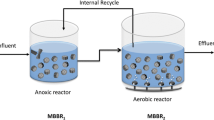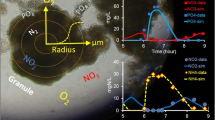Abstract
A pseudo-analytical solution for a Nonsteady-state Biofilm Model (NSBM) was used to describe heterotrophic and autotrophic biofilms within aerobic granules. This model was validated with the experimental results obtained from a granule-based SBR process that removes organics and ammonia simultaneously. The calibrated model (with boundary conditions including involved species, operating conditions, granular characteristics and biological reactions) predicted effluent COD and NH4 values that were in good agreement with the measured values. The model simulation showed that the increase of the substrate concentration did not dramatically influence the flux trends if the biomass concentration in the reactor is insufficient (less than 1000 mg VSS/L). The heterotrophic and autotrophic biofilms develop layer by layer on the outside of the aerobic granules. These can form simultaneously in independent patterns for substrate utilization and biomass growth. The NSBM could be an effective prediction method for the understanding of aerobic granulation.
Similar content being viewed by others
References
Adav, S. S., Lee, D. J., Show, K. Y., and Tay, J. H. (2008). “Aerobic granular sludge: Recent advances.” Biotechnol. Adv., Vol. 26, No. 5, pp. 411–423, DOI: 10.1016/j.biotechadv.2008.05.002.
APHA (American Public Health Association) (2005). Standard Methods for the Examination of Water and Wastewater. APHA, Washington, DC, USA.
Atkinson, B. and How, S. Y. (1974). “The overall rate of substrate uptake (reaction) by microbial films. Part II. Effect of concentration and thickness with mixed microbial films.” Trans. Inst. Chem., Vol. 52, pp. 260–272.
Beun, J. J., van Loosdrecht, M. C. M., and Heijnen, J. J. (2002). “Aerobic granulation in a sequencing batch airlift reactor.” Water. Res., Vol. 36, No. 3, pp. 702–712, DOI: 10.1016/S0043-1354(01)00250-0.
Cui, F. and Kim, M. (2013). “Use of steady-state biofilm model to characterize aerobic granular sludge.” Environ. Sci. Technology, Vol. 47, No. 21, pp. 12291–12296, DOI: 10.1021/es4025639.
Cui, F., Park, S., and Kim, M. (2014). “Characteristics of aerobic granulation at mesophilic temperatures in wastewater treatment.” Bioresour. Technol., Vol. 151, pp. 78–84, DOI: 10.1016/j.biortech.2013.10.025.
de Kreuk, M. K., Kishida, N., and van Loosdrecht, M. C. M. (2007). “Aerobic granular sludge–state of the art.” Water Sci. Technol., Vol. 155, Nos. 8–9, pp. 79–81, DOI: 10.2166/wst.2007.244.
Eckenfelder, W. W. and Musterman, J. L. (1995). Activated sludge treatment of industrial wastewater, Technomic Publishing Company, Lancaster, Pa.
Gonzalez-Gil, G., Seghezzo, L., Lettinga, G., and Kleerebezem, R. (2001). “Kinetics and mass-transfer phenomena in anaerobic granular sludge.” Biotechnol. Bioeng., Vol. 73, No. 2, pp. 125–134, DOI: 10.1002/bit.1044.
Henze, M., Gujer, W., Mino, T., and van Loosdrecht, M. (2000). Activated sludge models ASM1, ASM2, ASM2d and ASM3, IWA publsing, London, England.
Keller, J. and Yuan Z. (2002). “Combined hydraulic and biological modelling and full-scale validation of SBR process.” Water Sci. Technol., Vol. 45, No. 6, pp. 219–228, DOI: 10.2166/wst.2002.244.
Liu, Y. and Tay, J. H. (2004). “State of the art of biogranulatioin technology for wastewater treatment.” Biotechnol. Adv., Vol. 22, No. 7, pp. 533–563, DOI: 10.1016/j.biotechadv.2004.05.001.
Liu, Y. Q., Liu, Y., and Tay, J. H. (2004). “The effects of extracellular polymeric substances on the formation and stability of biogranules.” Appl. Microbiol. Biotechnol, Vol. 65, No. 2, pp. 143–148, DOI: 10.1007/s00253-004-1657-8.
Ni, B. J. and Yu, H. Q. (2010). “Mathematical modeling of aerobic granular sludge: A review.” Biotechnol. Adv., Vol. 28, No. 6, pp. 895–909, DOI: 10.1016/j.biotechadv.2010.08.004.
Ni, B. J., Yu, H. Q., and Sun, Y. J. (2008). “Modeling simultaneous autotrophic and heterotrophic growth in aerobic granules.” Water Res., Vol. 42, Nos. 6–7, pp. 1583–1594, DOI: 10.1016/j.watres.2007. 11.010.
Nicolella, C., van Loosdrecht, M. C. M., and Heijnen, J. J. (1998). “Mass transfer and reaction in a biofilm airlift suspension reactor.” Chem. Eng. Sci., Vol. 53, No. 15, pp. 2743–2753, DOI: 10.1016/S0009-2509(98)00107-9.
Rittman, B. E. and McCarty, P. L. (1981). “Substrate flux into biofilms of any thickness.” J. Environ. Engr., Vol. 107, No. 4, pp. 831–849.
Rittmann, B. E. (2001). Environmental biotechnology: Principles and application, McGraw-Hill, New York.
Vazquez-Padin, J. R., Mosquera-Corral, A., Campos, J. L., Mendez, R., Carrera, J., and Perez, J. (2010). “Modelling aerobic granular SBR at variable COD/N ratios including accurate description of total solids concentration.” Biochem. Eng. J., Vol. 49, No. 2, pp. 173–184, DOI: 10.1016/j.bej.2009.12.009.
Wanner, O., Eberl, H., Morgenroth, E., Noguera, D., Picioreanu, C., Rittmann, B., and van Loosdrecht, M. (2006). Mathematical modeling of biofilm, IWA publishing, London, pp. 59–68.
Xavier, J. B., De Kreuk, M. K., and van Loosdrecht, M. C. M. (2007). “Multi-scale individual-based model of microbial and bioconversion dynamics in aerobic granular sludge.” Environ. Sci. Technol., Vol. 41, No. 18, pp. 6410–6417, DOI: 10.1021/es070264m.
Yang, S. F., Tay, J. H., and Liu, Y. (2004). “Respirometric activities of heterotrophic and nitrifying populations in aerobic granules developed at different substrate N/COD ratios.” Curr. Microbiol., Vol. 49, No. 1, pp. 42–96, DOI: 10.1007/s00284-004-4266-y.
Yang, S. F., Tay, J. H., and Liu, Y. (2005). “Effect of substrate nitrogen/chemical oxygen demand ratio on the formation of aerobic granules.” J. Environ. Eng., Vol. 131, No. 1, pp. 86–92, DOI: 10.1061/(ASCE) 0733-9372(2005)131:1(86).
Zhou, M., Gong, J. Y., Yang, C. Z., and Pu, W. H. (2013). “Simulation of the performance of aerobic granular sludge SBR using modified ASM3 model.” Bioresour. Technol., Vol. 127, pp. 473–481, DOI: 10.1016/j.biortech.2012.09.076.
Author information
Authors and Affiliations
Corresponding author
Rights and permissions
About this article
Cite this article
Kim, M., Cui, F. Use of Nonsteady-state Biofilm Model to characterize heterotrophic and autotrophic biomass within aerobic granules. KSCE J Civ Eng 21, 2584–2589 (2017). https://doi.org/10.1007/s12205-017-1245-y
Received:
Revised:
Accepted:
Published:
Issue Date:
DOI: https://doi.org/10.1007/s12205-017-1245-y




